Confinement, Comfort and Health: Analysis of the Real Influence of Lockdown on University Students during the COVID-19 Pandemic
Abstract
1. Introduction
2. Materials and Methods
2.1. Context of the Study
2.2. Sample and Type of Research
2.3. Ethical Aspects
3. Results
3.1. Results in Health
3.2. Results in Comfort
3.2.1. Soundproofing and Natural Light in the Home
3.2.2. Privacy and Social Relations
3.2.3. Leisure Activities and Exercise
3.2.4. Adequacy of Study Space
3.2.5. Thermal Sensation during Confinement
3.3. Housing-Related Results
3.3.1. Overall Evaluation of the Home
3.3.2. Type of Dwelling
3.3.3. Characteristics of the Dwelling
3.3.4. Environment
3.3.5. Modifications to the Home after Lockdown
4. Discussion
5. Conclusions
Author Contributions
Funding
Institutional Review Board Statement
Informed Consent Statement
Data Availability Statement
Acknowledgments
Conflicts of Interest
References
- Vinceti, M.; Filippini, T.; Rothman, K.J.; Ferrari, F.; Goffi, A.; Maffeis, G.; Orsini, N. Lockdown Timing and Efficacy in Controlling COVID-19 Using Mobile Phone Tracking. EClinicalMedicine 2020, 25. [Google Scholar] [CrossRef]
- Kraemer, M.U.G.; Yang, C.H.; Gutierrez, B.; Wu, C.H.; Klein, B.; Pigott, D.M.; du Plessis, L.; Faria, N.R.; Li, R.; Hanage, W.P.; et al. The Effect of Human Mobility and Control Measures on the COVID-19 Epidemic in China. Science 2020, 368, 493–497. [Google Scholar] [CrossRef]
- Glover, R.; Akl, E.; Kristjannson, E.; Lotfi, T.; Petkovic, J.; Petticrew, M.; Pottie, K.; Tugwell, P.; Welch, V. A Framework for Identifying and Mitigating the Equity Harms of COVID-19 Policy Interventions. J. Clin. Epidemiol. 2020, 128, 35–48. [Google Scholar] [CrossRef] [PubMed]
- Amerio, A.; Brambilla, A.; Morganti, A.; Aguglia, A.; Bianchi, D.; Santi, F.; Costantini, L.; Odone, A.; Costanza, A.; Signorelli, C.; et al. COVID-19 Lockdown: Housing Built Environment’s Effects on Mental Health. Int. J. Environ. Res. Public Health 2020, 17, 5973. [Google Scholar] [CrossRef] [PubMed]
- Asfaw, E.K.; Guo, E.S.; Jang, S.S.; Komarivelli, S.R.; Lewis, K.A.; Sandler, C.B.; Mehdipanah, R. Students’ Perspectives: How Will COVID-19 Shape the Social Determinants of Health and Our Future as Public Health Practitioners? Health Educ. Behav. 2020, 47, 850. [Google Scholar] [CrossRef]
- Narici, M.; De Vito, G.; Franchi, M.; Paoli, A.; Moro, T.; Marcolin, G.; Grassi, B.; Baldassarre, G.; Zuccarelli, L.; Biolo, G.; et al. Impact of Sedentarism Due to the COVID-19 Home Confinement on Neuromuscular, Cardiovascular and Metabolic Health: Physiological and Pathophysiological Implications and Recommendations for Physical and Nutritional Countermeasures. Eur. J. Sport Sci. 2021, 21, 614–635. [Google Scholar] [CrossRef] [PubMed]
- Renzo, L.D.; Gualtieri, P.; Cinelli, G.; Bigioni, G.; Soldati, L.; Attinà, A.; Bianco, F.F.; Caparello, G.; Camodeca, V.; Carrano, E.; et al. Psychological Aspects and Eating Habits during Covid-19 Home Confinement: Results of Ehlc-Covid-19 Italian Online Survey. Nutrients 2020, 12, 2152. [Google Scholar] [CrossRef] [PubMed]
- Oni, T.; Micklesfield, L.K.; Wadende, P.; Obonyo, C.O.; Woodcock, J.; Mogo, E.R.I.; Odunitan-Wayas, F.A.; Assah, F.; Tatah, L.; Foley, L.; et al. Implications of COVID-19 Control Measures for Diet and Physical Activity, and Lessons for Addressing Other Pandemics Facing Rapidly Urbanising Countries. Glob. Health Action 2020, 13. [Google Scholar] [CrossRef]
- López-Bueno, R.; Calatayud, J.; Casaña, J.; Casajús, J.A.; Smith, L.; Tully, M.A.; Andersen, L.L.; López-Sánchez, G.F. COVID-19 Confinement and Health Risk Behaviors in Spain. Front. Psychol. 2020, 11, 1–10. [Google Scholar] [CrossRef]
- Lotzin, A.; Acquarini, E.; Ajdukovic, D.; Ardino, V.; Böttche, M.; Bondjers, K.; Bragesjö, M.; Dragan, M.; Grajewski, P.; Figueiredo-Braga, M.; et al. Stressors, Coping and Symptoms of Adjustment Disorder in the Course of the COVID-19 Pandemic—Study Protocol of the European Society for Traumatic Stress Studies (ESTSS) Pan-European Study. Eur. J. Psychotraumatol. 2020, 11. [Google Scholar] [CrossRef]
- How COVID-19 is Changing the World: A Statistical Perspective. Available online: https://openknowledge.worldbank.org/handle/10986/33773 (accessed on 1 December 2020).
- Biviá-Roig, G.; La Rosa, V.; Gómez-Tébar, M.; Serrano-Raya, L.; Amer-Cuenca, J.; Caruso, S.; Commodari, E.; Barrasa-Shaw, A.; Lisón, J. Analysis of the Impact of the Confinement Resulting from COVID-19 on the Lifestyle and Psychological Wellbeing of Spanish Pregnant Women: An Internet-Based Cross-Sectional Survey. Int. J. Environ. Res. Public Health 2020, 17, 5933. [Google Scholar] [CrossRef]
- Rodríguez-Pérez, C.; Molina-Montes, E.; Verardo, V.; Artacho, R.; García-Villanova, B.; Ruíz-López, M. Changes in Dietary Behaviours during the COVID-19 Outbreak Confinement in the Spanish COVIDiet Study. Nutrients 2020, 12, 1730. [Google Scholar] [CrossRef] [PubMed]
- Mackinnon, L.; Socías, M.E.; Bardwell, G. COVID-19 and Overdose Prevention: Challenges and Opportunities for Clinical Practice in Housing Settings. J. Subst. Abuse Treat. 2020, 119, 108153. [Google Scholar] [CrossRef]
- Megahed, N.A.; Ghoneim, E.M. Antivirus-Built Environment: Lessons Learned from Covid-19 Pandemic. Sustain. Cities Soc. 2020, 61, 102350. [Google Scholar] [CrossRef] [PubMed]
- Zhang, X.; Pellegrino, F.; Shen, J.; Copertaro, B.; Huang, P.; Kumar Saini, P.; Lovati, M. A Preliminary Simulation Study about the Impact of COVID-19 Crisis on Energy Demand of a Building Mix at a District in Sweden. Appl. Energy 2020, 280, 115954. [Google Scholar] [CrossRef]
- D’Alessandro, D.; Gola, M.; Appolloni, L.; Dettori, M.; Fara, G.M.; Rebecchi, A.; Settimo, G.; Capolongo, S. COVID-19 and Living Space Challenge. Well-Being and Public Health Recommendations for a Healthy, Safe, and Sustainable Housing. Acta Biomed. 2020, 91, 61. [Google Scholar] [CrossRef]
- Tokazhanov, G.; Tleuken, A.; Guney, M.; Turkyilmaz, A.; Karaca, F. How Is COVID-19 Experience Transforming Sustainability Requirements of Residential Buildings? A Review. Sustainability 2020, 12, 8732. [Google Scholar] [CrossRef]
- Cuerdo-Vilches, T.; Navas-Martín, M.Á.; Oteiza, I. A Mixed Approach on Resilience of Spanish Dwellings and Households during COVID-19 Lockdown. Sustainability 2020, 12, 10198. [Google Scholar] [CrossRef]
- INDOOR DAMPNESS AND ASTHMA - Clearing the Air - NCBI Bookshelf. Available online: https://www.ncbi.nlm.nih.gov/books/NBK224480/ (accessed on 19 January 2021).
- Stokstad, E. Asthma Linked to Indoor Dampness; American Association for the Advancement of Science: Washington, DC, USA, 2004; Volume 304. [Google Scholar]
- Jaakkola, M.S.; Nordman, H.; Piipari, R.; Uitti, J.; Laitinen, J.; Karjalainen, A.; Hahtola, P.; Jaakkola, J.J.K. Indoor Dampness and Molds and Development of Adult-Onset Asthma: A Population-Based Incident Case-Control Study. Environ. Health Perspect. 2002, 110, 543–547. [Google Scholar] [CrossRef]
- Zock, J.P.; Jarvis, D.; Luczynska, C.; Sunyer, J.; Burney, P.; Burney, P.; Chinn, S.; Luczynska, C.; Jarvis, D.; Lai, E.; et al. Housing Characteristics, Reported Mold Exposure, and Asthma in the European Community Respiratory Health Survey. J. Allergy Clin. Immunol. 2002, 110, 285–292. [Google Scholar] [CrossRef] [PubMed]
- Keall, M.D.; Crane, J.; Baker, M.G.; Wickens, K.; Howden-Chapman, P.; Cunningham, M. A Measure for Quantifying the Impact of Housing Quality on Respiratory Health: A Cross-Sectional Study. Environ. Heal. A Glob. Access Sci. Source 2012, 11, 33. [Google Scholar] [CrossRef] [PubMed]
- Colton, M.D.; Laurent, J.G.C.; MacNaughton, P.; Kane, J.; Bennett-Fripp, M.; Spengler, J.; Adamkiewicz, G. Health Benefits of Green Public Housing: Associations with Asthma Morbidity and Building-Related Symptoms. Am. J. Public Health 2015, 105, 2482–2489. [Google Scholar] [CrossRef] [PubMed]
- Ulrich, R.S. Effects of Interior Design on Wellness: Theory and Recent Scientific Research. J. Health Care Inter. Design 1991, 3, 97–109. [Google Scholar]
- Andrade, C.C.; Devlin, A.S. Stress Reduction in the Hospital Room: Applying Ulrich’s Theory of Supportive Design. J. Environ. Psychol. 2015, 41, 125–134. [Google Scholar] [CrossRef]
- Caniato, M.; Gasparella, A. Discriminating People’s Attitude towards Building Physical Features in Sustainable and Conventional Buildings. Energies 2019, 12, 1429. [Google Scholar] [CrossRef]
- Evans, G.W.; Wells, N.M.; Moch, A. Housing and Mental Health: A Review of the Evidence and a Methodological and Conceptual Critique. J. Soc. Issues 2003, 59, 475–500. [Google Scholar] [CrossRef]
- Evans, G.W.; Wells, N.M.; Chan, H.Y.E.; Saltzmand, H. Housing Quality and Mental Health. J. Consult. Clin. Psychol. 2000, 68, 526–530. [Google Scholar] [CrossRef]
- Karol, E.; Smith, D. Impact of Design on Emotional, Psychological, or Social Well-Being for People With Cognitive Impairment. HERD: Health Environ. Res. Des. J. 2019, 12, 220–232. [Google Scholar] [CrossRef]
- Odriozola-González, P.; Planchuelo-Gómez, Á.; Irurtia, M.J.; de Luis-García, R. Psychological Effects of the COVID-19 Outbreak and Lockdown among Students and Workers of a Spanish University. Psychiatry Res. 2020, 290, 113108. [Google Scholar] [CrossRef]
- Al-Sabbah, S.; Darwish, A.; Fares, N.; Barnes, J.; Almomani, J.A. Biopsychosocial Factors Linked with Overall Well-Being of Students and Educators during the COVID-19 Pandemic. Cogent Psychol. 2021, 8, 1875550. [Google Scholar] [CrossRef]
- Domínguez-Salas, S.; Gómez-Salgado, J.; Andrés-Villas, M.; Díaz-Milanés, D.; Romero-Martín, M.; Ruiz-Frutos, C. Psycho-Emotional Approach to the Psychological Distress Related to the COVID-19 Pandemic in Spain: A Cross-Sectional Observational Study. Healthcare 2020, 8, 190. [Google Scholar] [CrossRef] [PubMed]
- María del Carmen, P.F.; María del Mar, M.J.; Martínez, Á.M.; Gázquez Linares, J.J. Threat of COVID-19 and Emotional State during Quarantine: Positive and Negative Affect as Mediators in a Cross-Sectional Study of the Spanish Population. PLoS ONE 2020, 15. [Google Scholar] [CrossRef]
- De Las Heras-Pedrosa, C.; Sánchez-Núñez, P.; Peláez, J. Sentiment Analysis and Emotion Understanding during the COVID-19 Pandemic in Spain and Its Impact on Digital Ecosystems. Int. J. Environ. Res. Public Health 2020, 17, 5542. [Google Scholar] [CrossRef] [PubMed]
- Herrera-Limones, R.; Millán-Jiménez, A.; López-Escamilla, Á.; Torres-García, M. Health and Habitability in the Solar Decathlon University Competitions: Statistical Quantification and Real Influence on Comfort Conditions. Int. J. Environ. Res. Public Health 2020, 17, 5926. [Google Scholar] [CrossRef]
- López-Escamilla, Á.; Herrera-Limones, R.; León-Rodríguez, Á.L.; Torres-García, M. Environmental Comfort as a Sustainable Strategy for Housing Integration: The AURA 1.0 Prototype for Social Housing. Appl. Sci. 2020, 10, 7734. [Google Scholar] [CrossRef]
- Herrera, R.; Pineda, P.; Roa, J.; Cordero, S.; López-Escamilla, Á. Project AURA: Sustainable Social Housing. In Sustainable Development and Renovation in Architecture, Urbanism and Engineering; Springer International Publishing: Cham, Germany, 2017; pp. 277–287. [Google Scholar] [CrossRef]
- Herrera-Limones, R.; León-Rodríguez, Á.; López-Escamilla, Á. Solar Decathlon Latin America and Caribbean: Comfort and the Balance between Passive and Active Design. Sustainability 2019, 11, 3498. [Google Scholar] [CrossRef]
- Solar Decathlon LatinAmerica&Caribbean 2015. RULES Final Version. Available online: https://solardecathlonlac.com/competencia/reglas/ (accessed on 10 December 2015).
- Simon, J.; National Renewable Energy Laboratory. Solar Decathlon 2017 Draft Rules. Available online: https://www.solardecathlon.gov/2017/assets/pdfs/sd2017-rules_final.pdf (accessed on 3 December 2017).
- Herrera-Limones, R.; Rey-Pérez, J.; Hernández-Valencia, M.; Roa-Fernández, J. Student Competitions as a Learning Method with a Sustainable Focus in Higher Education: The University of Seville “Aura Projects” in the “Solar Decathlon 2019”. Sustainability 2020, 12, 1634. [Google Scholar] [CrossRef]
- Cornaro, C.; Rossi, S.; Cordiner, S.; Mulone, V.; Ramazzotti, L.; Rinaldi, Z. Energy Performance Analysis of STILE House at the Solar Decathlon 2015: Lessons Learned. J. Build. Eng. 2017, 13, 11–27. [Google Scholar] [CrossRef]
- Fantozzi, F.; Leccese, F.; Salvadori, G.; Spinelli, N.; Moggio, M.; Pedonese, C.; Formicola, L.; Mangiavacchi, E.; Baroni, M.; Vegnuti, S.; et al. Solar Decathlon ME18 Competition as a “learning by Doing” Experience for Students: The Case of the Team HAAB. In Proceedings of the IEEE Global Engineering Education Conference, EDUCON, Santa Cruz de Tenerife, Spain, 17–20 April 2018; pp. 1865–1869. [Google Scholar] [CrossRef]
- Chiuini, M.; Grondzik, W.; King, K.; McGinley, M.; Owens, J. Architect and Engineer Collaboration: The Solar Decathlon as a Pedagogical Opportunity. In Proceedings of the AEI 2013: Building Solutions for Architectural Engineering—Proceedings of the 2013 Architectural Engineering National Conference, State College, PA, USA, 3–5 April 2013; pp. 215–224. [Google Scholar] [CrossRef]
- Ma, Z.; Ren, H.; Lin, W. A Review of Heating, Ventilation and Air Conditioning Technologies and Innovations Used in Solar-Powered Net Zero Energy Solar Decathlon Houses. J. Clean. Prod. 2019, 240, 118158. [Google Scholar] [CrossRef]
- Peng, C.; Huang, L.; Liu, J.; Huang, Y. Design and Practical Application of an Innovative Net-Zero Energy House with Integrated Photovoltaics: A Case Study from Solar Decathlon China 2013. Archit. Sci. Rev. 2015, 58, 144–161. [Google Scholar] [CrossRef]
- Cronemberger, J.; Corpas, M.A.; Cerón, I.; Caamaño-Martín, E.; Sánchez, S.V. BIPV Technology Application: Highlighting Advances, Tendencies and Solutions through Solar Decathlon Europe Houses. Energy Build. 2014, 83, 44–56. [Google Scholar] [CrossRef]
- Terrados, F.J.; Moreno, D. “Patio” and “Botijo”: Energetic Strategies’ Architectural Integration in “Patio 2.12” Prototype. Energy Build. 2014, 83, 70–88. [Google Scholar] [CrossRef]
- Bohm, M. Energy Technology and Lifestyle: A Case Study of the University at Buffalo 2015 Solar Decathlon Home. Renew. Energy 2018, 123, 92–103. [Google Scholar] [CrossRef]
- Ferrara, M.; Lisciandrello, C.; Messina, A.; Berta, M.; Zhang, Y.; Fabrizio, E. Optimizing the Transition between Design and Operation of ZEBs: Lessons Learnt from the Solar Decathlon China 2018 SCUTxPoliTo Prototype. Energy Build. 2020, 213, 109824. [Google Scholar] [CrossRef]
- Luna-Tintos, J.F.; Cobreros, C.; Herrera-Limones, R.; López-Escamilla, Á. “Methodology Comparative Analysis” in the Solar Decathlon Competition: A Proposed Housing Model Based on a Prefabricated Structural System. Sustainability 2020, 12, 1882. [Google Scholar] [CrossRef]
- Luna-Tintos, J.; Cobreros, C.; López-Escamilla, Á.; Herrera-Limones, R.; Torres-García, M. Methodology to Evaluate the Embodied Primary Energy and CO2 Production at Each Stage of the Life Cycle of Prefabricated Structural Systems: The Case of the Solar Decathlon Competition. Energies 2020, 13, 4311. [Google Scholar] [CrossRef]
- Serra Soriano, B.; Verdejo Gimeno, P.; Díaz Segura, A.; Merí De La Maza, R. Assembling Sustainable Ideas: The Construction Process of the Proposal SMLsystem at the Solar Decathlon Europe 2012. Energy Build. 2014, 83, 186–194. [Google Scholar] [CrossRef]
- Battista, G.; Carnielo, E.; Evangelisti, L.; Frascarolo, M.; Vollaro, R. Energy Performance and Thermal Comfort of a High Efficiency House: RhOME for DenCity, Winner of Solar Decathlon Europe 2014. Sustainability 2015, 7, 9681–9695. [Google Scholar] [CrossRef]
- Ammar, A.; Trabelsi, K.; Brach, M.; Chtourou, H.; Boukhris, O.; Masmoudi, L.; Bouaziz, B.; Bentlage, E.; How, D.; Ahmed, M.; et al. Effects of Home Confinement on Mental Health and Lifestyle Behaviours during the COVID-19 Outbreak: Insight from the “ECLB-COVID19” Multi Countries Survey. Biol. Sport 2021, 38, 9. [Google Scholar] [CrossRef]
- Gómez-Salgado, J.; Andrés-Villas, M.; Domínguez-Salas, S.; Díaz-Milanés, D.; Ruiz-Frutos, C. Related Health Factors of Psychological Distress During the COVID-19 Pandemic in Spain. Int. J. Environ. Res. Public Health 2020, 17, 3947. [Google Scholar] [CrossRef]
- Domínguez-Amarillo, S.; Fernández-Agüera, J.; Cesteros-García, S.; González-Lezcano, R.A. Bad Air Can Also Kill: Residential Indoor Air Quality and Pollutant Exposure Risk during the COVID-19 Crisis. Int. J. Environ. Res. Public Health 2020, 17, 7183. [Google Scholar] [CrossRef]
- Portal Plan Nacional sobre Drogas—Observatorio Español de las Drogas y las Adicciones (OEDA). Available online: https://pnsd.sanidad.gob.es/profesionales/sistemasInformacion/home.htm (accessed on 8 April 2021).
- Pellegrini, M.; Ponzo, V.; Rosato, R.; Scumaci, E.; Goitre, I.; Benso, A.; Belcastro, S.; Crespi, C.; De Michieli, F.; Ghigo, E.; et al. Changes in Weight and Nutritional Habits in Adults with Obesity during the “Lockdown” Period Caused by the COVID-19 Virus Emergency. Nutrients 2020, 12, 2016. [Google Scholar] [CrossRef] [PubMed]
- Huber, B.C.; Steffen, J.; Schlichtiger, J.; Brunner, S. Altered Nutrition Behavior during COVID-19 Pandemic Lockdown in Young Adults. Eur. J. Nutr. 2020, 1–10. [Google Scholar] [CrossRef]
- Ruiz-Roso, M.B.; de Carvalho Padilha, P.; Mantilla-Escalante, D.C.; Ulloa, N.; Brun, P.; Acevedo-Correa, D.; Arantes Ferreira Peres, W.; Martorell, M.; Aires, M.T.; de Oliveira Cardoso, L.; et al. Covid-19 Confinement and Changes of Adolescent’s Dietary Trends in Italy, Spain, Chile, Colombia and Brazil. Nutrients 2020, 12, 1807. [Google Scholar] [CrossRef] [PubMed]
- WHO. Mental Health and Psychosocial Considerations During COVID-19 Outbreak. Available online: https://apps.who.int/iris/bitstream/handle/10665/331490/WHO-2019-nCoV-MentalHealth-2020.1-eng.pdf (accessed on 25 March 2021).
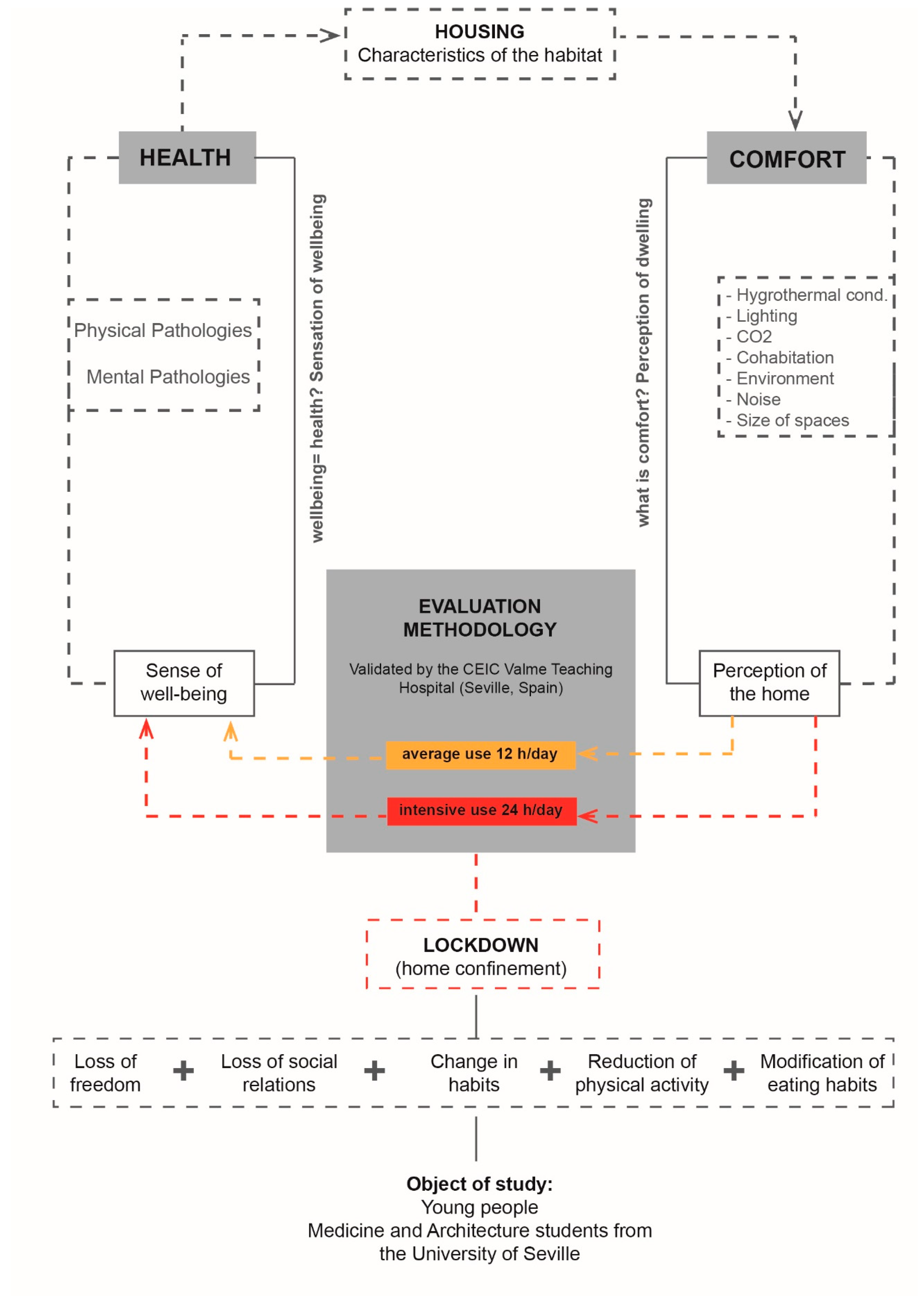
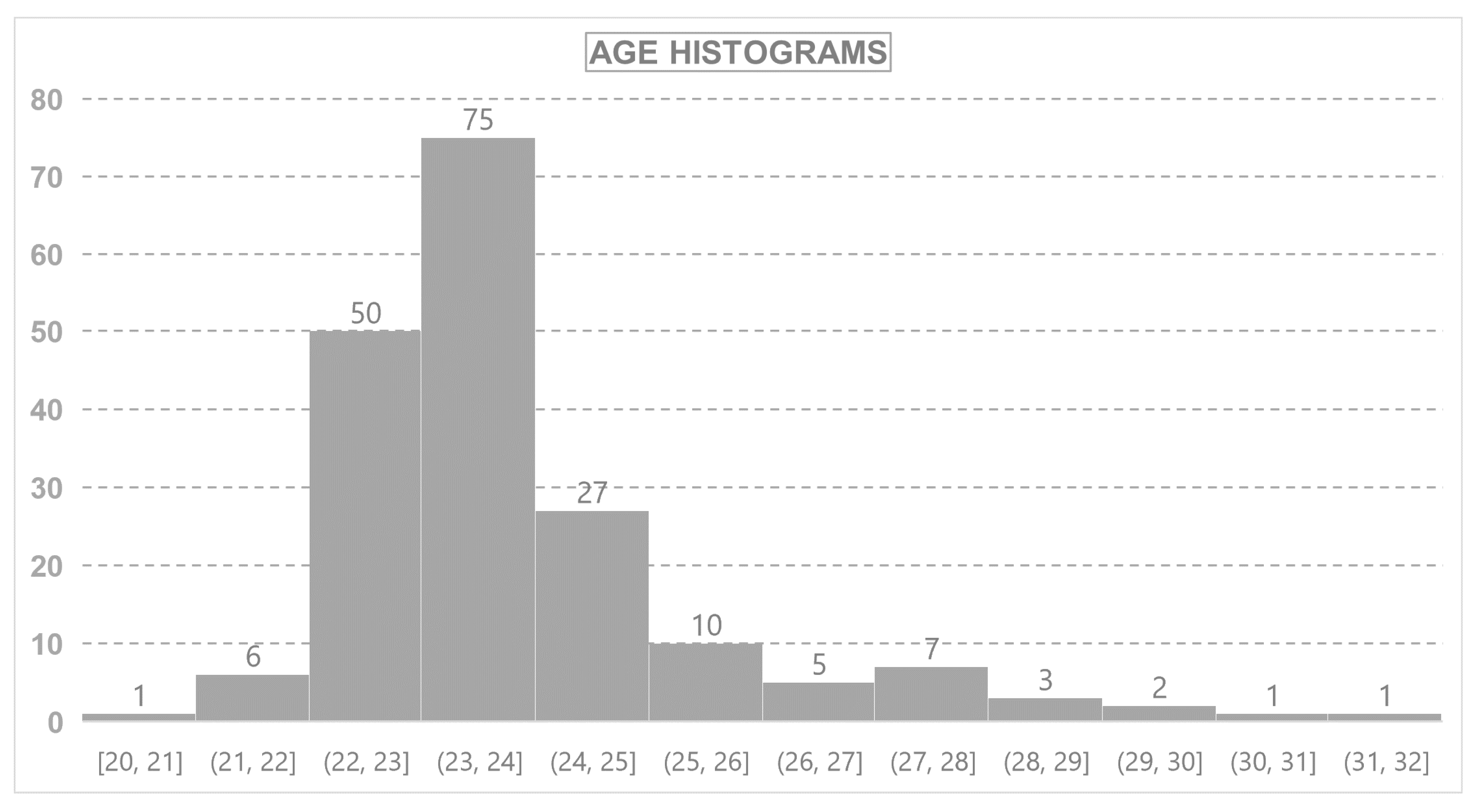
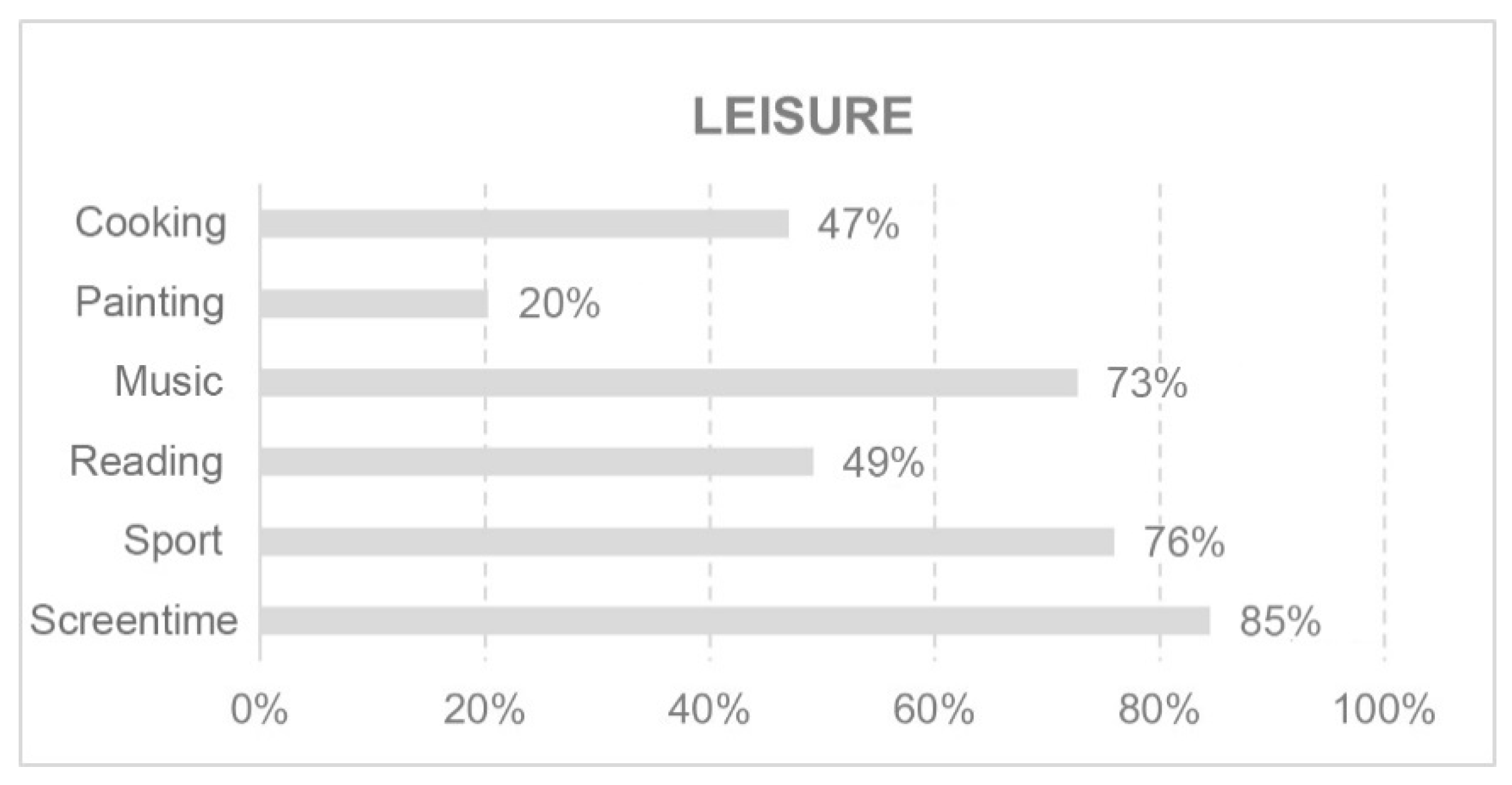
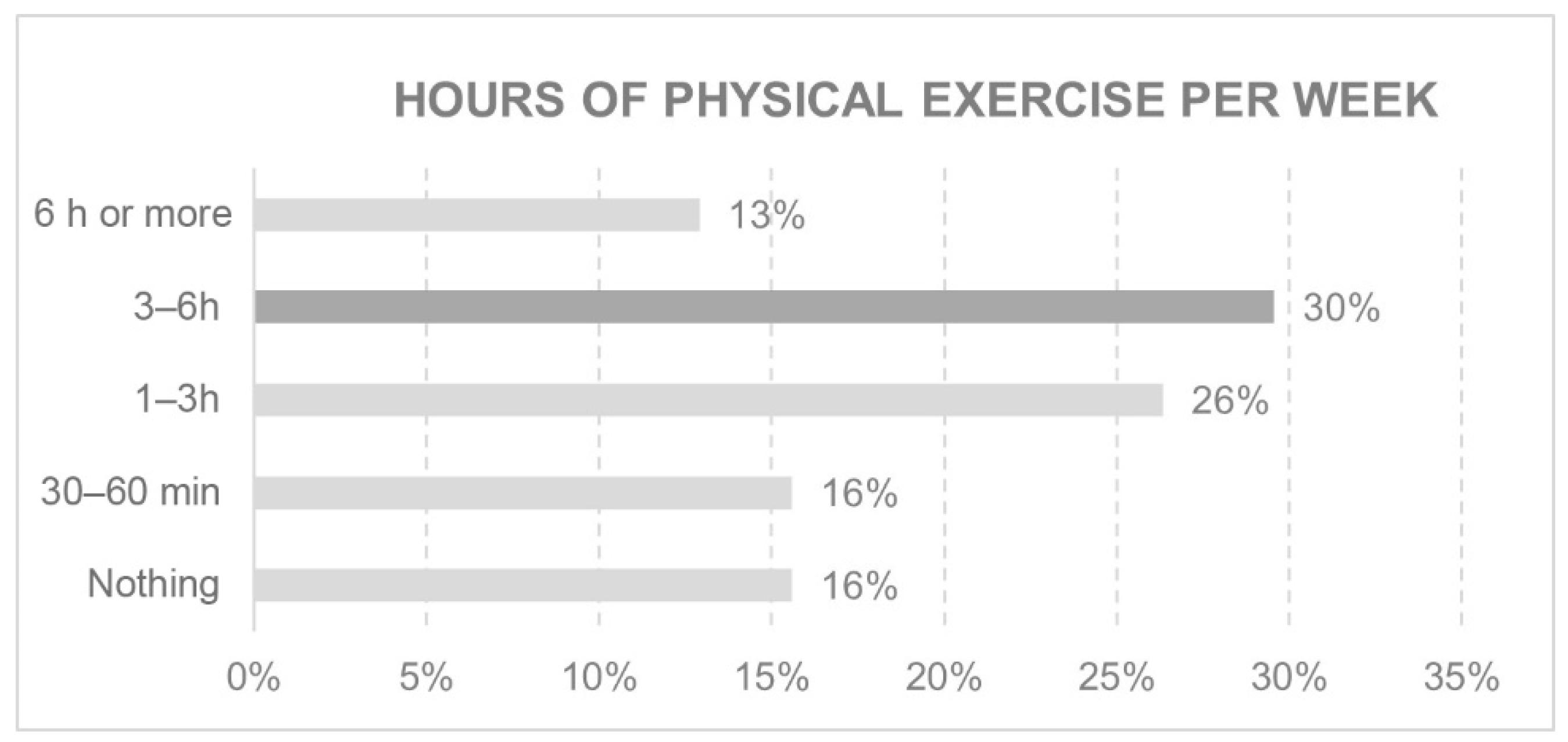
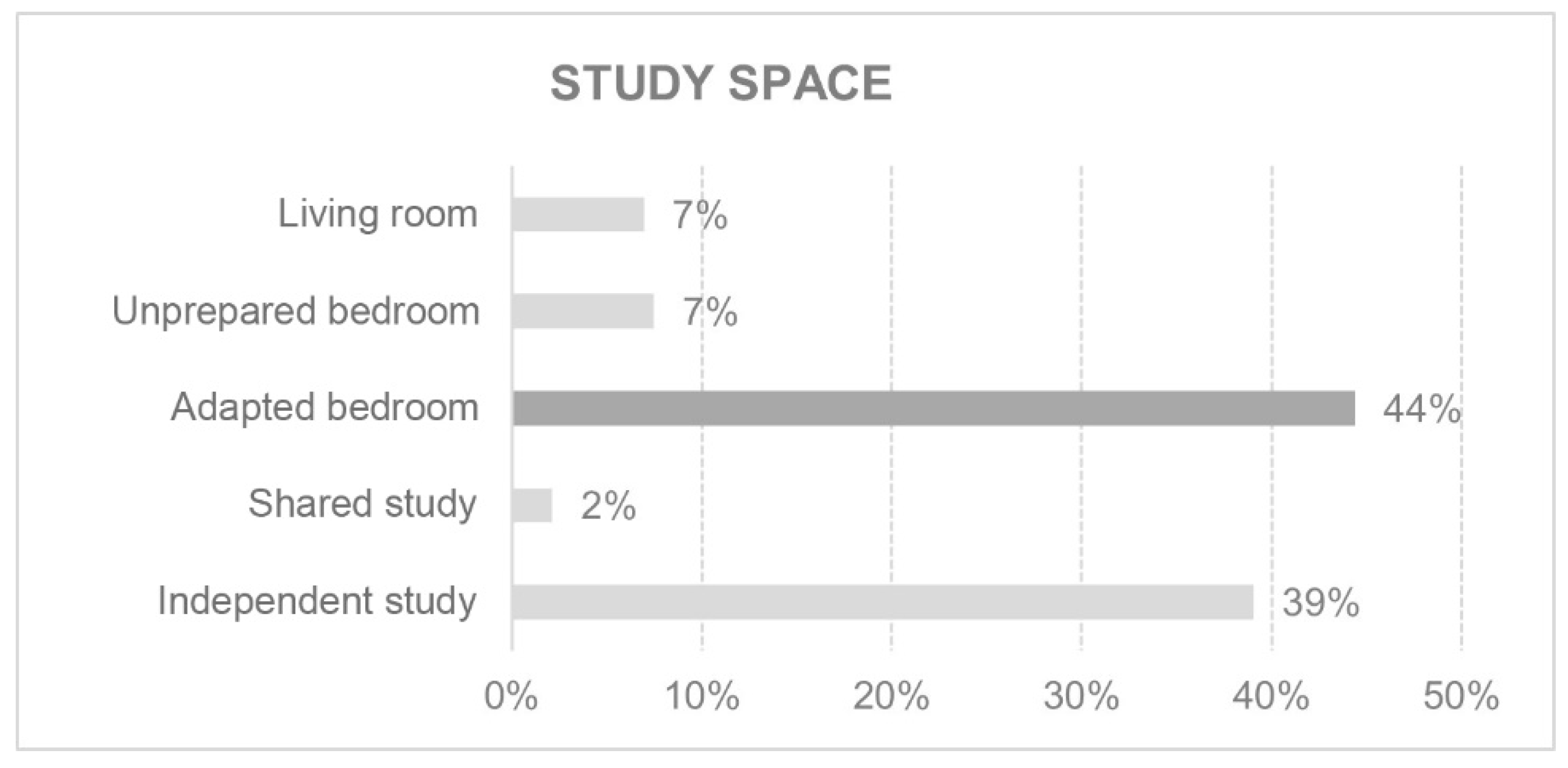
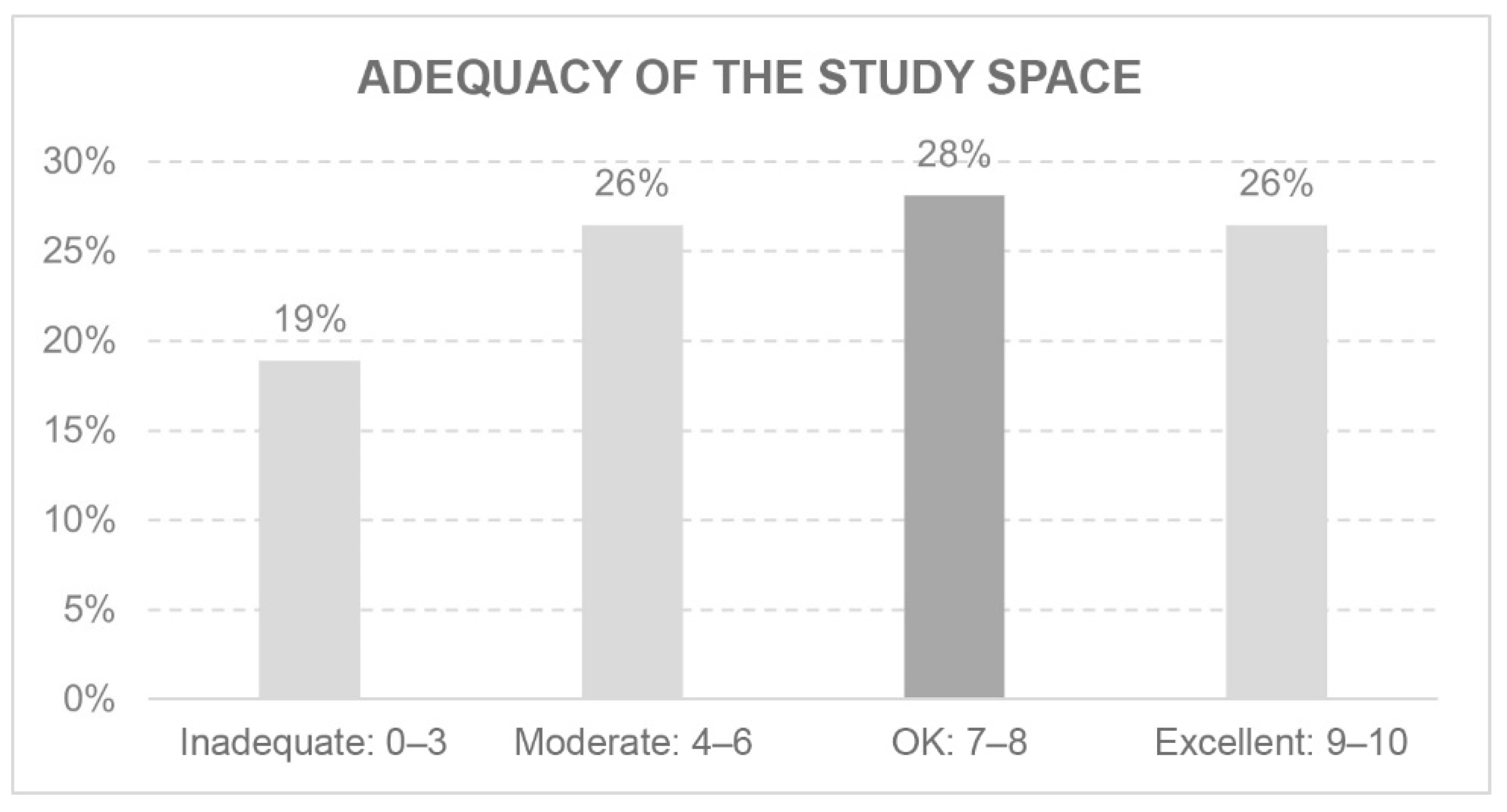

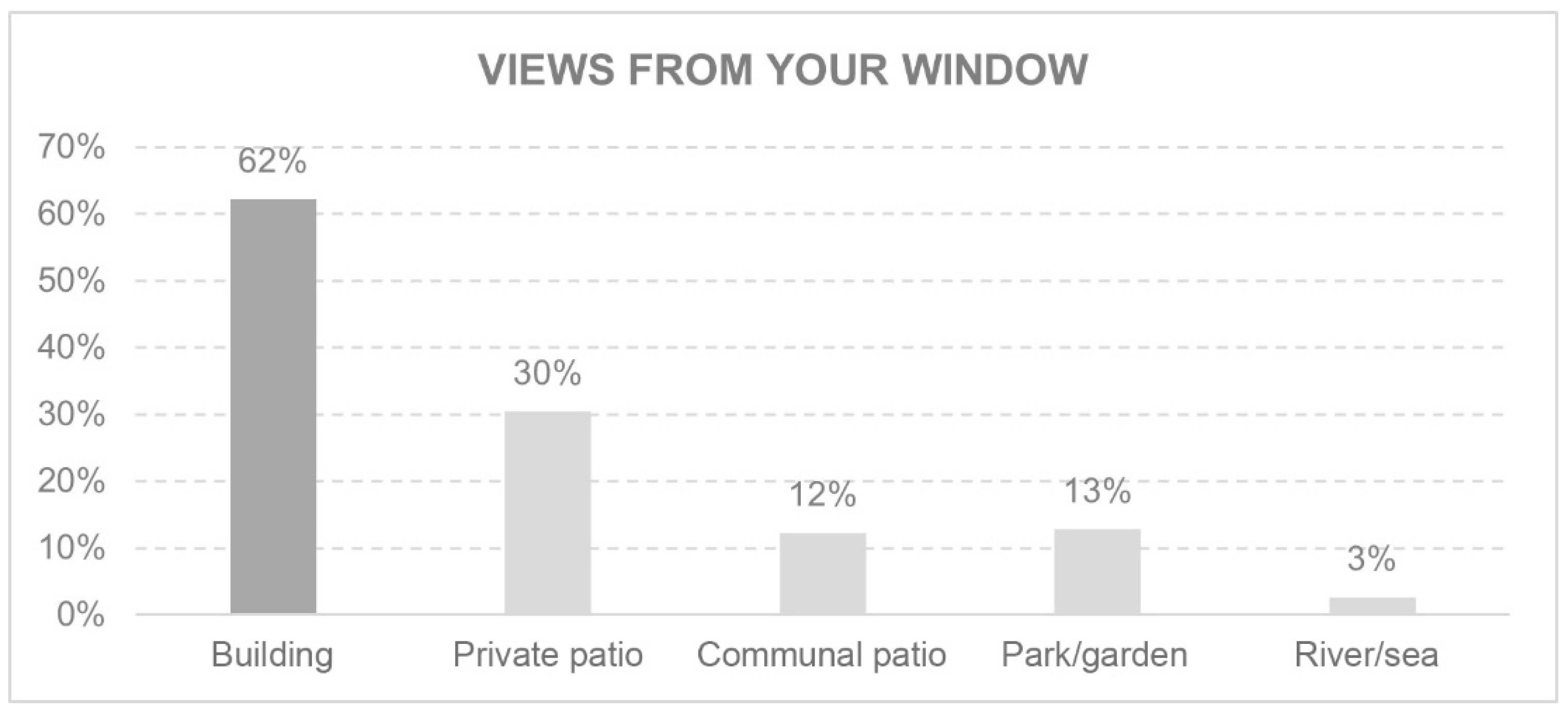

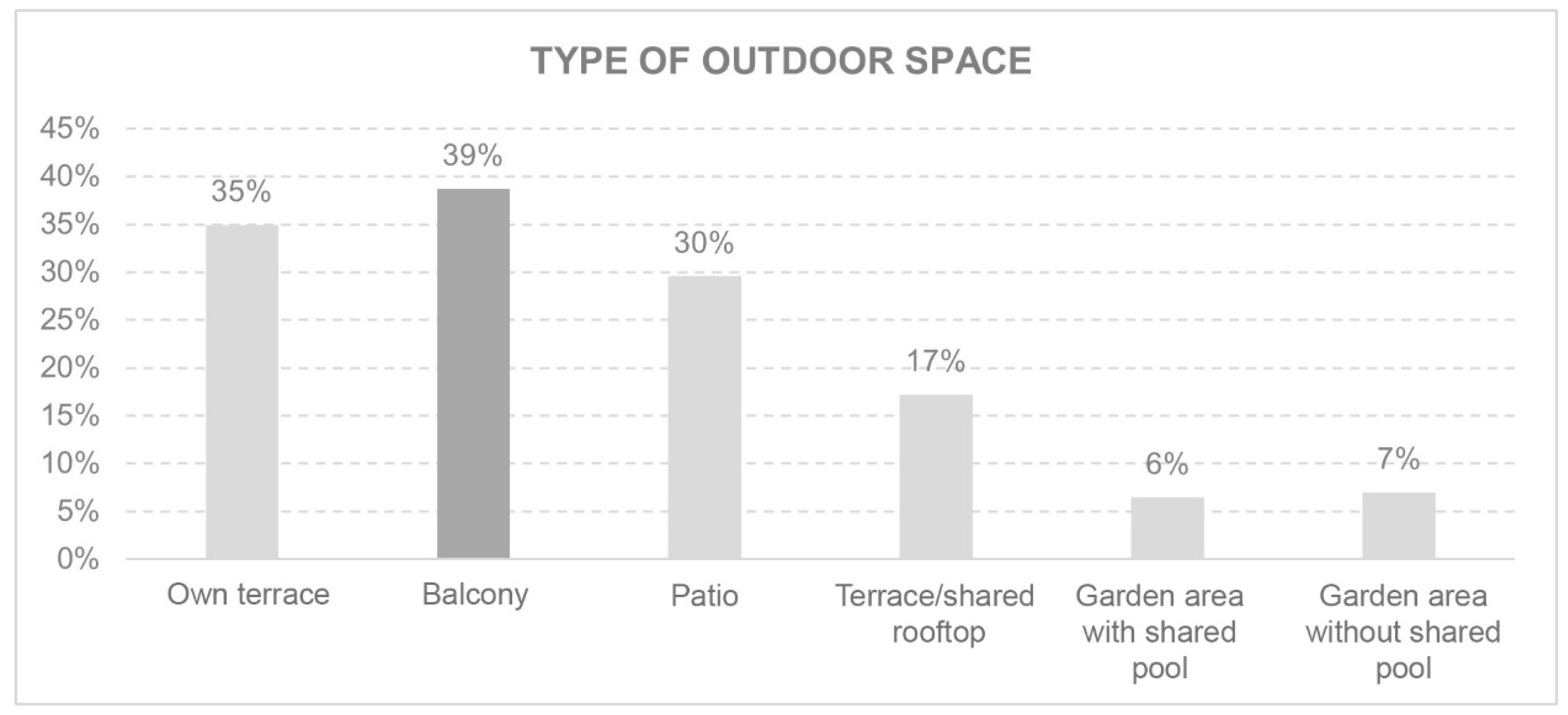
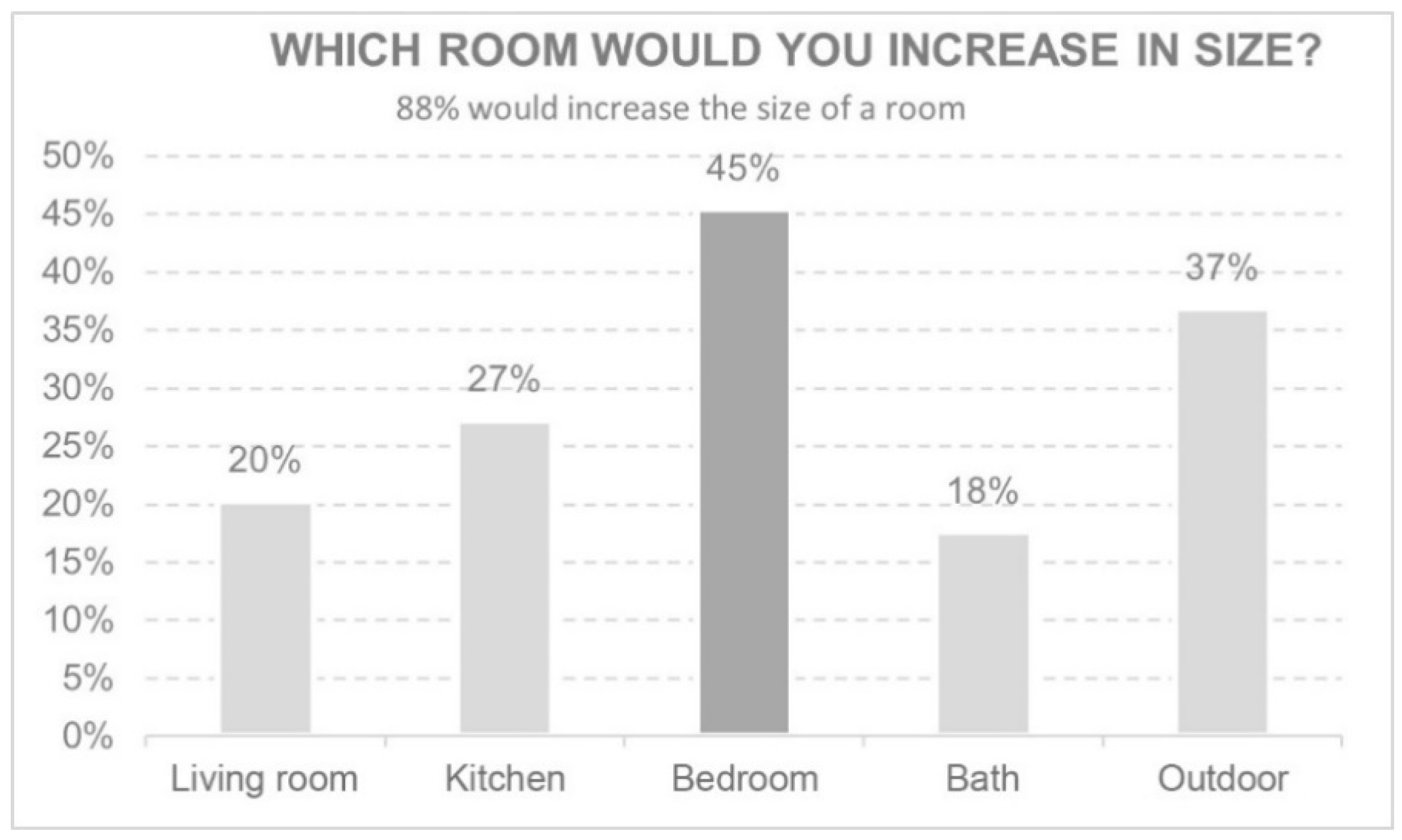
| Participants | Age (Average and Standard Deviation) | |
|---|---|---|
| Medicine | 133 (70%) | 24.64 (2.27) |
| Architecture | 55 (30%) | 24.35 (2.33) |
| Female | 128 (68%) | 24.65 (2.56) |
| Male | 60 (32%) | 24.35 (1.53) |
| Total | 188 (100%) | 24.55 (2.29) |
| Results in health | n = 188 (%) |
|---|---|
| Type of pathology | |
| Digestive | 60 (32.3) |
| Respiratory | 18 (9.6) |
| Neuro-psychiatric | 168 (89.4) |
| Infectious | 42 (22.3) |
| Neuro-psychiatric pathology | |
| Migraine or Headache | 70 (37.3) |
| Insomnia | 93 (49.5) |
| Depression symptoms | 92 (48.9) |
| Anxiety | 106 (56.4) |
| Lack of rest | 89 (47.3) |
| Irritability or bad moods | 81 (43.1) |
| Use of toxic substances | |
| Hashish | 2 (1.1) |
| Marijuana | 7 (3.7) |
| Tobacco | 28 (14.9) |
| Alcohol | 110 (58.5) |
| Results in comfort | n = 188 (%) |
|---|---|
| Night-time noise | |
| Nothing (0–1) | 81 (43) |
| Low (2–4) | 76 (40) |
| Moderate (5–6) | 19 (10) |
| Substantial (7–8) | 12 (6) |
| Daytime noise | |
| Nothing (0–1) | 16 (9) |
| Low (2–4) | 56 (30) |
| Moderate (5–6) | 58 (31) |
| Substantial (7–8) | 58 (31) |
| Hours of natural light | |
| Five or more | 139 (74) |
| Four | 17 (9) |
| Three | 12 (6) |
| Two | 7 (4) |
| One | 6 (3) |
| No natural Light | 7 (4) |
| Need for artificial lighting | |
| At the start and end of the day | 120 (64) |
| All day | 68 (36) |
Publisher’s Note: MDPI stays neutral with regard to jurisdictional claims in published maps and institutional affiliations. |
© 2021 by the authors. Licensee MDPI, Basel, Switzerland. This article is an open access article distributed under the terms and conditions of the Creative Commons Attribution (CC BY) license (https://creativecommons.org/licenses/by/4.0/).
Share and Cite
Millán-Jiménez, A.; Herrera-Limones, R.; López-Escamilla, Á.; López-Rubio, E.; Torres-García, M. Confinement, Comfort and Health: Analysis of the Real Influence of Lockdown on University Students during the COVID-19 Pandemic. Int. J. Environ. Res. Public Health 2021, 18, 5572. https://doi.org/10.3390/ijerph18115572
Millán-Jiménez A, Herrera-Limones R, López-Escamilla Á, López-Rubio E, Torres-García M. Confinement, Comfort and Health: Analysis of the Real Influence of Lockdown on University Students during the COVID-19 Pandemic. International Journal of Environmental Research and Public Health. 2021; 18(11):5572. https://doi.org/10.3390/ijerph18115572
Chicago/Turabian StyleMillán-Jiménez, Antonio, Rafael Herrera-Limones, Álvaro López-Escamilla, Emma López-Rubio, and Miguel Torres-García. 2021. "Confinement, Comfort and Health: Analysis of the Real Influence of Lockdown on University Students during the COVID-19 Pandemic" International Journal of Environmental Research and Public Health 18, no. 11: 5572. https://doi.org/10.3390/ijerph18115572
APA StyleMillán-Jiménez, A., Herrera-Limones, R., López-Escamilla, Á., López-Rubio, E., & Torres-García, M. (2021). Confinement, Comfort and Health: Analysis of the Real Influence of Lockdown on University Students during the COVID-19 Pandemic. International Journal of Environmental Research and Public Health, 18(11), 5572. https://doi.org/10.3390/ijerph18115572







